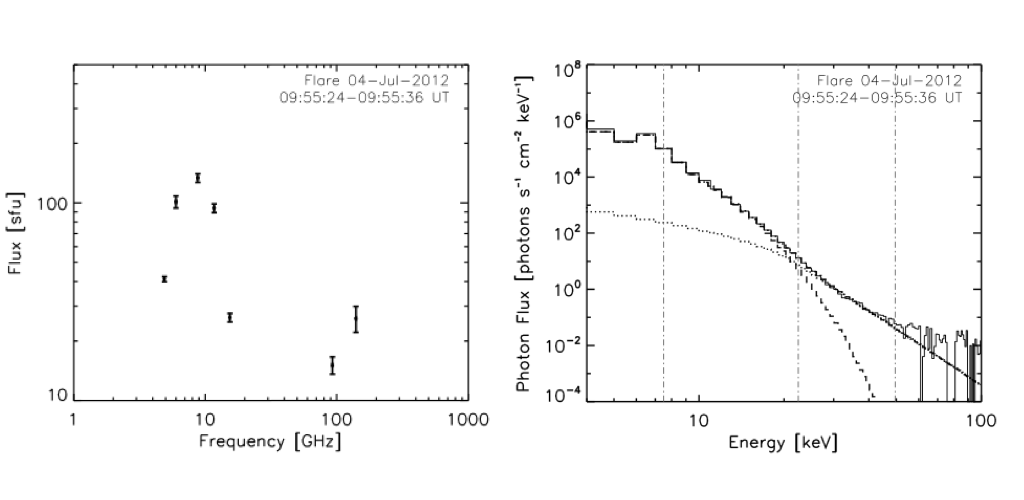The nature of the solar flare sub-THz emission (Kaufmann, 2012) with a positive spectral slope at 200-400 GHz is still not clear [see also previous CESRA highlight]. Some authors associate this emission with thermal bremsstrahlung, while other suggest it is associated with different, non-thermal mechanisms (see Fleishman & Kontar, 2010; Krucker et al., 2013). There are two serious disadvantages of the existing approaches. First, there is a lack of observations in the 100-200 GHz frequency range, where a transition from low to high frequency mechanisms of sub-THz emission can occur. Second, the X-ray emission data are not always fully exploited. The aim of this work is to consider the 4 July 2012 solar flare with a positive spectral slope (Fig.1, left panel) using millimeter (93, 140 GHz) and X-ray observations.
 Fig.1. Left panel: the time averaged (09:55:24-09:55:36 UT) radio flux density spectrum of the 4 July 2012 solar flare at frequencies 5.0, 6.1, 11.7, 8.8, and 15.4 GHz as well as 93 and 140 GHz (RT-7.5, Bauman Moscow State Technical University). Right panel: the time averaged RHESSI X-ray spectrum (background subtracted data, solid line) fitted with the isothermal (dashed line) and thick-target (doted line) models in the energy range from 7 to 50 keV. The dash-dotted line shows the sum of the fits.
Fig.1. Left panel: the time averaged (09:55:24-09:55:36 UT) radio flux density spectrum of the 4 July 2012 solar flare at frequencies 5.0, 6.1, 11.7, 8.8, and 15.4 GHz as well as 93 and 140 GHz (RT-7.5, Bauman Moscow State Technical University). Right panel: the time averaged RHESSI X-ray spectrum (background subtracted data, solid line) fitted with the isothermal (dashed line) and thick-target (doted line) models in the energy range from 7 to 50 keV. The dash-dotted line shows the sum of the fits.
Thermal and non-thermal components of emission from the 4 July solar flare
Supposing the common population of the low (obtain \( \lesssim\)100 kеV) and high (\(\gtrsim\) 100 kеV) energy electrons, it easy to show that the number density of high energy electrons is \(n_h \approx n_l (E_l/E_h)^{\delta_l -1}\), where \(n_l\) is the number density of the hard X-ray emitting electrons with the spectral index \(\delta_l\), and \(E_l\) and \(E_h\) are the lower limits of low and high energy electrons, respectively. Using this expression and the results of the X-ray spectral fitting for the 4 July 2012 solar flare (Fig.1, right panel) we obtain \(n_h \lesssim 4 \times 10^4\) cm\(^{-3}\). Since the value of \(n_h\) is too small, the non-thermal electrons can not be responsible for the observed millimeter emission. In turn, as it follows from the differential emission measure calculations based on SDO/AIA data, the thermal coronal plasma (0.5-20 MK) gives very small contribution to millimeter emission. These circumstances as well as the results of numerical simulations suggest that millimeter emission could be determined by the thermal bremsstrahlung emission of the plasma with temperature of about 0.1 MK (source area \(\approx 4 \times 10^4\) cm\(^2\), geometric thickness \(\approx 10^9\) cm).
Conclusions
– A non-thermal mechanism is not required to explain the spectral peculiarities of the emission between 93 and 140 GHz from the 4 July 2012 solar flare.
– The observed millimeter emission can be caused by the thermal bremsstrahlung emission of the cool plasma with a temperature of about 0.1 MK.
– The origin of the cool 0.1 MK plasma is not quite clear.
Additional info is available in the paper or preprint by Tsap et al, Advances in Space Research, 2016, 57, 1449
Authors: *Yuriy Tsap, Galina Motorina, Eduard Kontar, Viktoria Smirnova, Alexander Morgachev
References:
Fleishman, G.D., Kontar E.P., 2010, Astrophys J Lett., 709, L127
Kaufmann, P., 2012, Sun: New Challenges, Astrophysics and Space Science Proceedings
Krucker et al., 2013, Astron. Astrophys. Rev., 21, id. #58.
